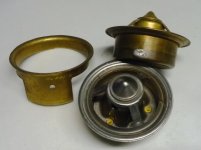Hi All,
I have really enjoyed this as high temperature, whether in the cooling system or cabin, represents one of the greatest issues of the Healey. I have appreciated the comments of Keith, Shortsguy1, and Jerry which have addressed specific components reinforced with some background theory. I must say that when considering the coolant as the heat transport from exchange 1 (engine Heat to coolant) to exchange 2 (coolant to ambient air), it becomes obvious that within the objective of expelling excess engine heat to ambient air, we are subject to a number of components and conditions within a not so simplistic cooling system. Yes, a faster transport (cooling flow rate) can carry heat from exchange to exchange and, as Shortsguy1 has properly well stated, will contribute to the potential for greater cooling. However, this efficiency is easily thwarted if heated air continues to recirculate through the radiator of if the engine bypass is left open to recirculate 25% of its heated coolant, or a number of other conditions as Jerry has well considered.
As I see it, we are addressing the improvement of the cooling system and therefore must address individual issues as components of that system. Although the improvement in coolant flow will contribute, it is a component and must be balanced to the requirements of other interfacing components to lend its improved contribution. It makes no sense to me to push for a faster coolant transport that can't eliminate its heat or have the best radiator when cooling air is blocked. When looking at our objective (Idle at 800-1000 RPMs for 2 hours on a 90 degree day without overheating) where are the problems and, with the elimination of the problems, how can we make it better. Yes, a faster coolant transport is a benefit but only after other well observed conditions are addressed. Additionally, any change I would consider would require that it is as close to incognito as possible, conservatively priced, reasonably reversible, and above all retains the character (from my perspective) of my Healey.
All the best and thank you for this thread,
Ray (64BJ8P1)

 Hi Guest!
Hi Guest!

 smilie in place of the real @
smilie in place of the real @
 Pretty Please - add it to our Events forum(s) and add to the calendar! >>
Pretty Please - add it to our Events forum(s) and add to the calendar! >> 


